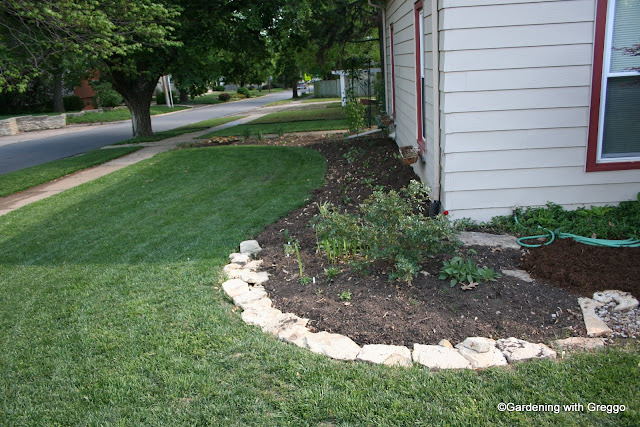This post entry will explain the third demonstration garden: The Hill Country Landscape. The Hill Country Garden is definitely my favorite, as I wish we could grow some of these plants here. As with the other gardens it has its own unique style and design features as defined by the signage. Click on image to read.
Below is the beginning of the garden, leaving the traditional garden along the decomposed granite path.
Immediately the landscape and composition change from traditional manicured to "Hill Country native" Texas style. Cut native limestone border edging delineates the two gardens. Juniperus ashei (Texas Cedar is a common name) posts compromise the sign fence structure, a nice rustic look. Spineless prickly pear, limestone outcropping boulders, Cercis canadensis var. texensis (Texas Redbud a similar cultivar to Eastern Redbud but more adaptable to the thin calcareous soils of the Texas Hill Country, it also has wavy, leathery leaves to inhibit transpiration and is usually more shrubby and multi-stemmed), Molinia (Beargass) I believe or Mulenbergia compromise the plantings in the above photos.
To the right of the signage is the entrance to the garden. Limestone outcrops and edging. DG pathway with native xeric plants and rustic cedar logs. An inviting entrance indeed.
The right side of the garden includes a wonderfully sculpted mesquite tree with salvia and I believe skullcap. A cedar rail fence delineates this garden from the next: the cottage garden.
But we will stay here a little longer as it is my favorite. View from further out below.
I suppose this isn't everyone's cup of tea. Many would feel it's over grown and messy. Not exactly a traditional suburban example is it?
I believe the plant above is a Grey Sotol (Dasylirion wheeleri) or some form of Dasylirion. It might jump out and bite you here however.
Red yucca, Stipa(mexican feather grass), sage, and prickly pear looking out from building.
Arizona Cypress next to building along with Dwarf Youpon Holly and Turks cap I believe in above photo.
Mahonia trifoliolata(Agarita)foreground with Spineless Prickly Pear and Leucophyllum frutescens(Texas sage,Cenzio).





































































